Implement virtual dom patch in vue (detailed tutorial)
This article mainly introduces the patch source code analysis of vue virtual dom. Now I will share it with you and give you a reference.
This article introduces the patch source code analysis of vue virtual dom and shares it with everyone. The details are as follows:
Source code directory: src/core/vdom/patch.js
function updateChildren (parentElm, oldCh, newCh, insertedVnodeQueue, removeOnly) {
let oldStartIdx = 0
let newStartIdx = 0
let oldEndIdx = oldCh.length - 1
let oldStartVnode = oldCh[0]
let oldEndVnode = oldCh[oldEndIdx]
let newEndIdx = newCh.length - 1
let newStartVnode = newCh[0]
let newEndVnode = newCh[newEndIdx]
let oldKeyToIdx, idxInOld, vnodeToMove, refElm
const canMove = !removeOnly
while (oldStartIdx <= oldEndIdx && newStartIdx <= newEndIdx) { // 开始索引大于结束索引,进不了
if (isUndef(oldStartVnode)) {
oldStartVnode = oldCh[++oldStartIdx] // Vnode已经被移走了。
} else if (isUndef(oldEndVnode)) {
oldEndVnode = oldCh[--oldEndIdx]
} else if (sameVnode(oldStartVnode, newStartVnode)) {
patchVnode(oldStartVnode, newStartVnode, insertedVnodeQueue)
oldStartVnode = oldCh[++oldStartIdx] // 索引加1。是去对比下一个节点。比如之前start=a[0],那现在start=a[1],改变start的值后再去对比start这个vnode
newStartVnode = newCh[++newStartIdx]
} else if (sameVnode(oldEndVnode, newEndVnode)) {
patchVnode(oldEndVnode, newEndVnode, insertedVnodeQueue)
oldEndVnode = oldCh[--oldEndIdx]
newEndVnode = newCh[--newEndIdx]
} else if (sameVnode(oldStartVnode, newEndVnode)) {
patchVnode(oldStartVnode, newEndVnode, insertedVnodeQueue)
canMove && nodeOps.insertBefore(parentElm, oldStartVnode.elm, nodeOps.nextSibling(oldEndVnode.elm))// 把节点b移到树的最右边
oldStartVnode = oldCh[++oldStartIdx]
newEndVnode = newCh[--newEndIdx]
} else if (sameVnode(oldEndVnode, newStartVnode)) { old.end.d=new.start.d
patchVnode(oldEndVnode, newStartVnode, insertedVnodeQueue)
canMove && nodeOps.insertBefore(parentElm, oldEndVnode.elm, oldStartVnode.elm)// Vnode moved left,把d移到c的左边。=old.start->old.end
oldEndVnode = oldCh[--oldEndIdx]
newStartVnode = newCh[++newStartIdx]
} else {
if (isUndef(oldKeyToIdx)) oldKeyToIdx = createKeyToOldIdx(oldCh, oldStartIdx, oldEndIdx)
idxInOld = isDef(newStartVnode.key)
? oldKeyToIdx[newStartVnode.key]
: findIdxInOld(newStartVnode, oldCh, oldStartIdx, oldEndIdx)
if (isUndef(idxInOld)) {
createElm(newStartVnode, insertedVnodeQueue, parentElm, oldStartVnode.elm) // 创建新节点,后面执行了nodeOps.insertBefore(parent, elm, ref)
} else {
vnodeToMove = oldCh[idxInOld]
/* istanbul ignore if */
if (process.env.NODE_ENV !== 'production' && !vnodeToMove) {
warn(
'It seems there are duplicate keys that is causing an update error. ' +
'Make sure each v-for item has a unique key.'
)
}
if (sameVnode(vnodeToMove, newStartVnode)) {
patchVnode(vnodeToMove, newStartVnode, insertedVnodeQueue)
oldCh[idxInOld] = undefined
canMove && nodeOps.insertBefore(parentElm, vnodeToMove.elm, oldStartVnode.elm)
} else {
// same key but different element. treat as new element
createElm(newStartVnode, insertedVnodeQueue, parentElm, oldStartVnode.elm)
}
}
newStartVnode = newCh[++newStartIdx]
}
}
if (oldStartIdx > oldEndIdx) {
refElm = isUndef(newCh[newEndIdx + 1]) ? null : newCh[newEndIdx + 1].elm
addVnodes(parentElm, refElm, newCh, newStartIdx, newEndIdx, insertedVnodeQueue)
} else if (newStartIdx > newEndIdx) {
removeVnodes(parentElm, oldCh, oldStartIdx, oldEndIdx) // 删除旧的c,removeNode(ch.elm)
}
}function sameVnode (a, b) {
return (
a.key === b.key && (
(
a.tag === b.tag &&
a.isComment === b.isComment &&
isDef(a.data) === isDef(b.data) &&
sameInputType(a, b)
) || (
isTrue(a.isAsyncPlaceholder) &&
a.asyncFactory === b.asyncFactory &&
isUndef(b.asyncFactory.error)
)
)
)
}
/**
* 比较新旧vnode节点,根据不同的状态对dom做合理的更新操作(添加,移动,删除)整个过程还会依次调用prepatch,update,postpatch等钩子函数,在编译阶段生成的一些静态子树,在这个过程
* @param oldVnode 中由于不会改变而直接跳过比对,动态子树在比较过程中比较核心的部分就是当新旧vnode同时存在children,通过updateChildren方法对子节点做更新,
* @param vnode
* @param insertedVnodeQueue
* @param removeOnly
*/
function patchVnode (oldVnode, vnode, insertedVnodeQueue, removeOnly) {
if (oldVnode === vnode) {
return
}
const elm = vnode.elm = oldVnode.elm
if (isTrue(oldVnode.isAsyncPlaceholder)) {
if (isDef(vnode.asyncFactory.resolved)) {
hydrate(oldVnode.elm, vnode, insertedVnodeQueue)
} else {
vnode.isAsyncPlaceholder = true
}
return
}
// 用于静态树的重用元素。
// 注意,如果vnode是克隆的,我们只做这个。
// 如果新节点不是克隆的,则表示呈现函数。
// 由热重加载api重新设置,我们需要进行适当的重新渲染。
if (isTrue(vnode.isStatic) &&
isTrue(oldVnode.isStatic) &&
vnode.key === oldVnode.key &&
(isTrue(vnode.isCloned) || isTrue(vnode.isOnce))
) {
vnode.componentInstance = oldVnode.componentInstance
return
}
let i
const data = vnode.data
if (isDef(data) && isDef(i = data.hook) && isDef(i = i.prepatch)) {
i(oldVnode, vnode)
}
const oldCh = oldVnode.children
const ch = vnode.children
if (isDef(data) && isPatchable(vnode)) {
for (i = 0; i < cbs.update.length; ++i) cbs.update[i](oldVnode, vnode)
if (isDef(i = data.hook) && isDef(i = i.update)) i(oldVnode, vnode)
}
if (isUndef(vnode.text)) {
if (isDef(oldCh) && isDef(ch)) {
if (oldCh !== ch) updateChildren(elm, oldCh, ch, insertedVnodeQueue, removeOnly)
} else if (isDef(ch)) {
if (isDef(oldVnode.text)) nodeOps.setTextContent(elm, '')
addVnodes(elm, null, ch, 0, ch.length - 1, insertedVnodeQueue)
} else if (isDef(oldCh)) {
removeVnodes(elm, oldCh, 0, oldCh.length - 1)
} else if (isDef(oldVnode.text)) {
nodeOps.setTextContent(elm, '')
}
} else if (oldVnode.text !== vnode.text) {
nodeOps.setTextContent(elm, vnode.text)
}
if (isDef(data)) {
if (isDef(i = data.hook) && isDef(i = i.postpatch)) i(oldVnode, vnode)
}
}
function insertBefore (parentNode, newNode, referenceNode) {
parentNode.insertBefore(newNode, referenceNode);
}
/**
*
* @param vnode根据vnode的数据结构创建真实的dom节点,如果vnode有children则会遍历这些子节点,递归调用createElm方法,
* @param insertedVnodeQueue记录子节点创建顺序的队列,每创建一个dom元素就会往队列中插入当前的vnode,当整个vnode对象全部转换成为真实的dom 树时,会依次调用这个队列中vnode hook的insert方法
* @param parentElm
* @param refElm
* @param nested
*/
let inPre = 0
function createElm (vnode, insertedVnodeQueue, parentElm, refElm, nested) {
vnode.isRootInsert = !nested // 过渡进入检查
if (createComponent(vnode, insertedVnodeQueue, parentElm, refElm)) {
return
}
const data = vnode.data
const children = vnode.children
const tag = vnode.tag
if (isDef(tag)) {
if (process.env.NODE_ENV !== 'production') {
if (data && data.pre) {
inPre++
}
if (
!inPre &&
!vnode.ns &&
!(
config.ignoredElements.length &&
config.ignoredElements.some(ignore => {
return isRegExp(ignore)
? ignore.test(tag)
: ignore === tag
})
) &&
config.isUnknownElement(tag)
) {
warn(
'Unknown custom element: <' + tag + '> - did you ' +
'register the component correctly? For recursive components, ' +
'make sure to provide the "name" option.',
vnode.context
)
}
}
vnode.elm = vnode.ns
? nodeOps.createElementNS(vnode.ns, tag)
: nodeOps.createElement(tag, vnode)
setScope(vnode)
/* istanbul ignore if */
if (__WEEX__) {
// in Weex, the default insertion order is parent-first.
// List items can be optimized to use children-first insertion
// with append="tree".
const appendAsTree = isDef(data) && isTrue(data.appendAsTree)
if (!appendAsTree) {
if (isDef(data)) {
invokeCreateHooks(vnode, insertedVnodeQueue)
}
insert(parentElm, vnode.elm, refElm)
}
createChildren(vnode, children, insertedVnodeQueue)
if (appendAsTree) {
if (isDef(data)) {
invokeCreateHooks(vnode, insertedVnodeQueue)
}
insert(parentElm, vnode.elm, refElm)
}
} else {
createChildren(vnode, children, insertedVnodeQueue)
if (isDef(data)) {
invokeCreateHooks(vnode, insertedVnodeQueue)
}
insert(parentElm, vnode.elm, refElm)
}
if (process.env.NODE_ENV !== 'production' && data && data.pre) {
inPre--
}
} else if (isTrue(vnode.isComment)) {
vnode.elm = nodeOps.createComment(vnode.text)
insert(parentElm, vnode.elm, refElm)
} else {
vnode.elm = nodeOps.createTextNode(vnode.text)
insert(parentElm, vnode.elm, refElm)
}
}
function insert (parent, elm, ref) {
if (isDef(parent)) {
if (isDef(ref)) {
if (ref.parentNode === parent) {
nodeOps.insertBefore(parent, elm, ref)
}
} else {
nodeOps.appendChild(parent, elm)
}
}
}
function removeVnodes (parentElm, vnodes, startIdx, endIdx) {
for (; startIdx <= endIdx; ++startIdx) {
const ch = vnodes[startIdx]
if (isDef(ch)) {
if (isDef(ch.tag)) {
removeAndInvokeRemoveHook(ch)
invokeDestroyHook(ch)
} else { // Text node
removeNode(ch.elm)
}
}
}
}##updateChildren method mainly passes while Loop to compare the child nodes of the two trees to update dom, and change the old one by comparing the new one to achieve the purpose of unifying the old and new.
a, b, c, d, etc. , different codenames represent different vnode, such as:
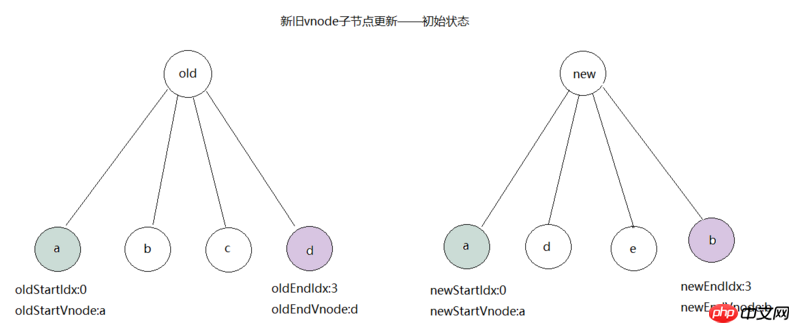
oldStartVnode=a, newStartVnode=a;If the sameVnode(oldStartVnode,newStartVnode) logic is hit, directly call the patchVnode(oldStartVnode,newStartVnode,insertedVnodeQueue) method to update the node a, then set the oldStartIdx and newStartIdx indexes to 1 respectively, as shown in the figure:
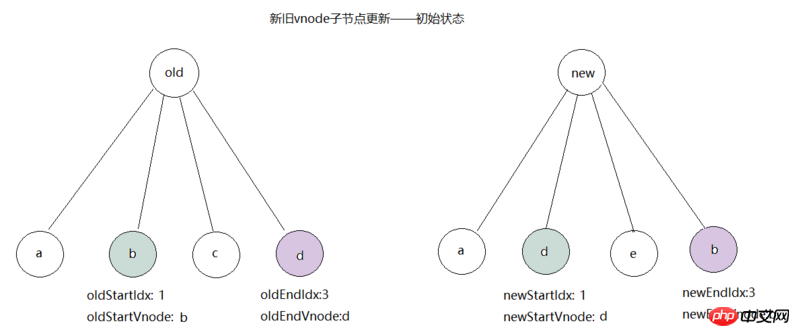
aAfter that, we start the second comparison. At this time, oldStartVnode=b,newEndVnode=b; hits the sameVnode(oldStartVnode,newEndVnode) logic, and then calls patchVnode( oldStartVnode, newEndVnode, insertedVnodeQueue) method to update the nodeb, and then call canMove && nodeOps.insertBefore(parentElm, oldStartVnode.elm, nodeOps.nextSibling(oldEndVnode.elm)), Move node b to the far right of the tree, and finally index oldStartIdx to 1 and newEndIdx to index -1, as shown in the figure:

b, we start the third comparison. At this time, oldEndVnode=d, newStartVnode=d; hits sameVnode(oldEndVnode, newStartVnode) Logic, call patchVnode(oldEndVnode, newStartVnode, insertedVnodeQueue) method to update the node d, and then call canMove && nodeOps.insertBefore(parentElm, oldEndVnode.elm, oldStartVnode. elm), move d to the left of c. Finally, index oldEndIdx to -1 and newStartIdx to index 1, as shown in the figure:
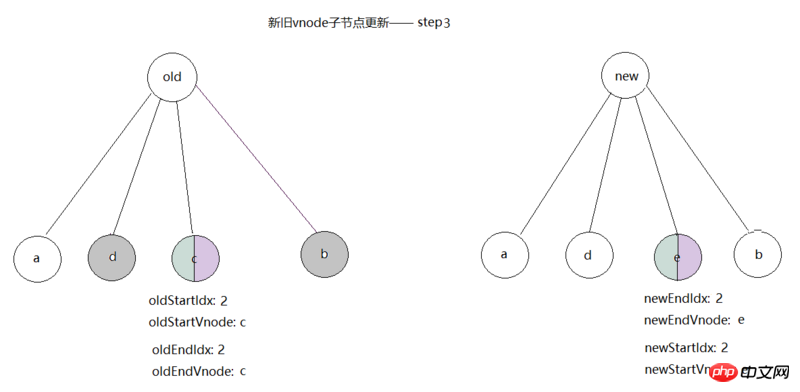 ##After updating
##After updating
, we start the fourth comparison. At this time newStartVnode=e, node e does not exist in the old tree, so it should be inserted as a new element, call createElm( newStartVnode, insertedVnodeQueue, parentElm, oldStartVnode.elm), and then the nodeOps.insertBefore(parent, elm, ref) method is executed to insert e before c , then index newStartIdx as 1, as shown in the figure: After
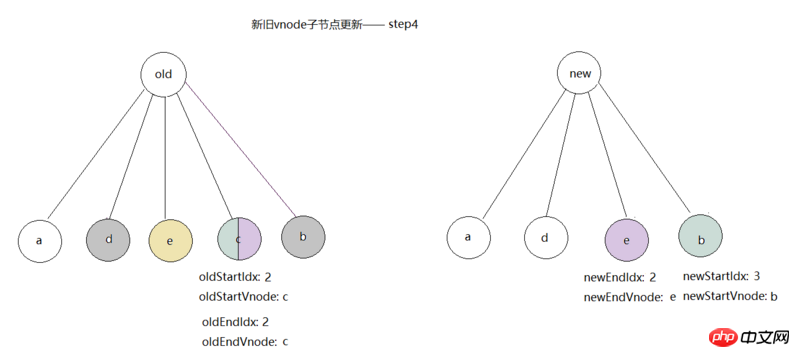 is inserted into node
is inserted into node
, we can see newStartIdx is already greater than newEndIdx, while loop has been completed. Then call removeVnodes(parentElm, oldCh, oldStartIdx, oldEndIdx) to delete the old c, as shown in the final figure:
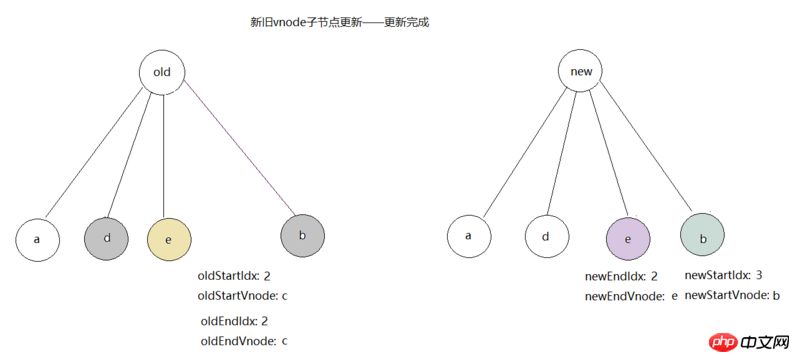
has completed the update of the child nodes of the old tree through the above steps. In fact, only relatively small dom operations are used, which improves the performance, and as the child nodes become more complex, this The improvement effect is more obvious. vnodeAfter generating dom through the patch method, mounted hook will be called. At this point, the entire vue instance is created Completed, when the watcher of this vue instance observes data changes, it will call the render method twice to generate a new vnode, Then call the patch method to compare the old and new vnode to update dom. The above is what I compiled for everyone. I hope it will be helpful to everyone in the future. .
Related articles:
JQuery selects the selected value method of the select component$set and array in vue.js Update method_vue.jsVue and vue-i18n are combined to implement multi-language switching method of background dataThe above is the detailed content of Implement virtual dom patch in vue (detailed tutorial). For more information, please follow other related articles on the PHP Chinese website!

Hot AI Tools

Undresser.AI Undress
AI-powered app for creating realistic nude photos

AI Clothes Remover
Online AI tool for removing clothes from photos.

Undress AI Tool
Undress images for free

Clothoff.io
AI clothes remover

Video Face Swap
Swap faces in any video effortlessly with our completely free AI face swap tool!

Hot Article

Hot Tools

Notepad++7.3.1
Easy-to-use and free code editor

SublimeText3 Chinese version
Chinese version, very easy to use

Zend Studio 13.0.1
Powerful PHP integrated development environment

Dreamweaver CS6
Visual web development tools

SublimeText3 Mac version
God-level code editing software (SublimeText3)

Hot Topics
 1386
1386
 52
52
 Tutorial on how to use Dewu
Mar 21, 2024 pm 01:40 PM
Tutorial on how to use Dewu
Mar 21, 2024 pm 01:40 PM
Dewu APP is currently a very popular brand shopping software, but most users do not know how to use the functions in Dewu APP. The most detailed usage tutorial guide is compiled below. Next is the Dewuduo that the editor brings to users. A summary of function usage tutorials. Interested users can come and take a look! Tutorial on how to use Dewu [2024-03-20] How to use Dewu installment purchase [2024-03-20] How to obtain Dewu coupons [2024-03-20] How to find Dewu manual customer service [2024-03-20] How to check the pickup code of Dewu [2024-03-20] Where to find Dewu purchase [2024-03-20] How to open Dewu VIP [2024-03-20] How to apply for return or exchange of Dewu
 Quark browser usage tutorial
Feb 24, 2024 pm 04:10 PM
Quark browser usage tutorial
Feb 24, 2024 pm 04:10 PM
Quark Browser is a very popular multi-functional browser at the moment, but most friends don’t know how to use the functions in Quark Browser. The most commonly used functions and techniques will be sorted out below. Next, the editor will guide users. Here is a summary of the multi-functional usage tutorials of Quark Browser. Interested users can come and take a look together! Tutorial on how to use Quark Browser [2024-01-09]: How to scan test papers to see answers on Quark [2024-01-09]: How to enable adult mode on Quark Browser [2024-01-09]: How to delete used space on Quark [2024 -01-09]: How to clean up the Quark network disk storage space [2024-01-09]: How to cancel the backup of Quark [2024-01-09]: Quark
 Upgrading numpy versions: a detailed and easy-to-follow guide
Feb 25, 2024 pm 11:39 PM
Upgrading numpy versions: a detailed and easy-to-follow guide
Feb 25, 2024 pm 11:39 PM
How to upgrade numpy version: Easy-to-follow tutorial, requires concrete code examples Introduction: NumPy is an important Python library used for scientific computing. It provides a powerful multidimensional array object and a series of related functions that can be used to perform efficient numerical operations. As new versions are released, newer features and bug fixes are constantly available to us. This article will describe how to upgrade your installed NumPy library to get the latest features and resolve known issues. Step 1: Check the current NumPy version at the beginning
 In summer, you must try shooting a rainbow
Jul 21, 2024 pm 05:16 PM
In summer, you must try shooting a rainbow
Jul 21, 2024 pm 05:16 PM
After rain in summer, you can often see a beautiful and magical special weather scene - rainbow. This is also a rare scene that can be encountered in photography, and it is very photogenic. There are several conditions for a rainbow to appear: first, there are enough water droplets in the air, and second, the sun shines at a low angle. Therefore, it is easiest to see a rainbow in the afternoon after the rain has cleared up. However, the formation of a rainbow is greatly affected by weather, light and other conditions, so it generally only lasts for a short period of time, and the best viewing and shooting time is even shorter. So when you encounter a rainbow, how can you properly record it and photograph it with quality? 1. Look for rainbows. In addition to the conditions mentioned above, rainbows usually appear in the direction of sunlight, that is, if the sun shines from west to east, rainbows are more likely to appear in the east.
 Tutorial on how to turn off the payment sound on WeChat
Mar 26, 2024 am 08:30 AM
Tutorial on how to turn off the payment sound on WeChat
Mar 26, 2024 am 08:30 AM
1. First open WeChat. 2. Click [+] in the upper right corner. 3. Click the QR code to collect payment. 4. Click the three small dots in the upper right corner. 5. Click to close the voice reminder for payment arrival.
 DisplayX (monitor testing software) tutorial
Mar 04, 2024 pm 04:00 PM
DisplayX (monitor testing software) tutorial
Mar 04, 2024 pm 04:00 PM
Testing a monitor when buying it is an essential part to avoid buying a damaged one. Today I will teach you how to use software to test the monitor. Method step 1. First, search and download the DisplayX software on this website, install it and open it, and you will see many detection methods provided to users. 2. The user clicks on the regular complete test. The first step is to test the brightness of the display. The user adjusts the display so that the boxes can be seen clearly. 3. Then click the mouse to enter the next link. If the monitor can distinguish each black and white area, it means the monitor is still good. 4. Click the left mouse button again, and you will see the grayscale test of the monitor. The smoother the color transition, the better the monitor. 5. In addition, in the displayx software we
 What software is photoshopcs5? -photoshopcs5 usage tutorial
Mar 19, 2024 am 09:04 AM
What software is photoshopcs5? -photoshopcs5 usage tutorial
Mar 19, 2024 am 09:04 AM
PhotoshopCS is the abbreviation of Photoshop Creative Suite. It is a software produced by Adobe and is widely used in graphic design and image processing. As a novice learning PS, let me explain to you today what software photoshopcs5 is and how to use photoshopcs5. 1. What software is photoshop cs5? Adobe Photoshop CS5 Extended is ideal for professionals in film, video and multimedia fields, graphic and web designers who use 3D and animation, and professionals in engineering and scientific fields. Render a 3D image and merge it into a 2D composite image. Edit videos easily
 Experts teach you! The Correct Way to Cut Long Pictures on Huawei Mobile Phones
Mar 22, 2024 pm 12:21 PM
Experts teach you! The Correct Way to Cut Long Pictures on Huawei Mobile Phones
Mar 22, 2024 pm 12:21 PM
With the continuous development of smart phones, the functions of mobile phones have become more and more powerful, among which the function of taking long pictures has become one of the important functions used by many users in daily life. Long screenshots can help users save a long web page, conversation record or picture at one time for easy viewing and sharing. Among many mobile phone brands, Huawei mobile phones are also one of the brands highly respected by users, and their function of cropping long pictures is also highly praised. This article will introduce you to the correct method of taking long pictures on Huawei mobile phones, as well as some expert tips to help you make better use of Huawei mobile phones.




